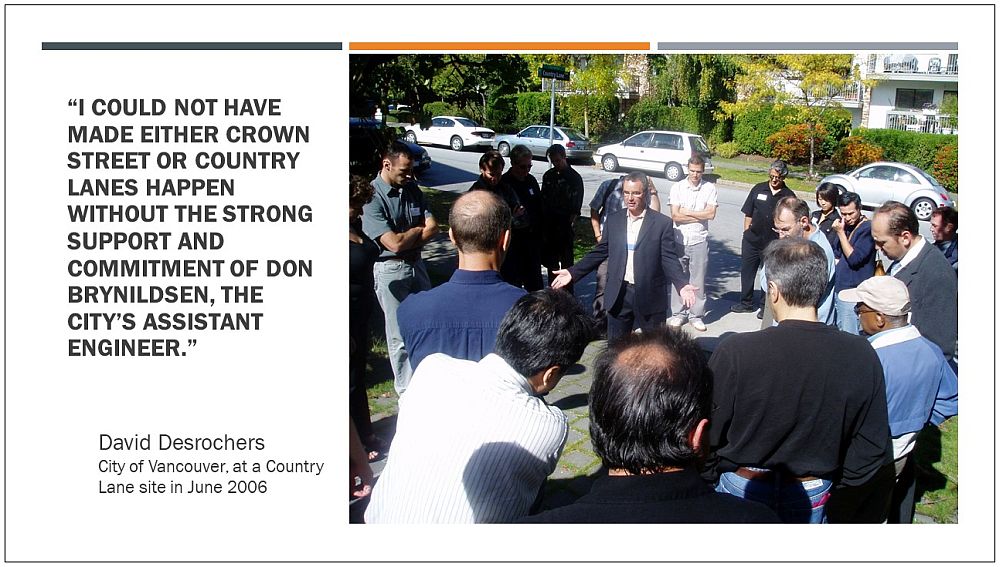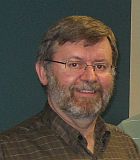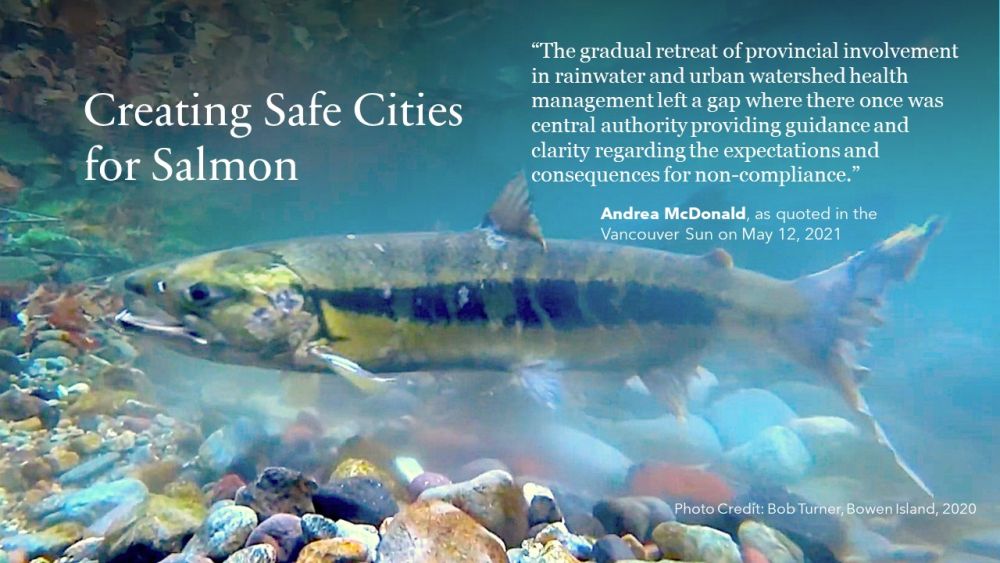FLASHBACK TO 2006: “Vancouver’s Green Streets Program for streetscape enhancement began in 1994 as a pilot project in Vancouver’s Mount Pleasant neighbourhood. The success of the project inspired other neighbourhoods to get involved and liven up their streets,” stated David Desrochers when the City of Vancouver and UBC co-hosted the third event in the pilot program for ‘Showcasing Green Infrastructure Innovation in the Metro Vancouver Region’
Note to Reader:
 In a feature article published by Pique Newsmagazine in May 2021, Stefan Labbé sets the context with this opening statement: “Green infrastructure promises to keep the worst of flooding and contaminated rivers at bay. But while it has set ambitious targets, Vancouver is falling behind many other big cities. Could Seattle offer an answer?” The article by Stefan Labbé provides a reason to connect the dots to the pioneering work of David Desrochers almost two decades. He was a trailblazer for the City and for the Metro Vancouver region..
In a feature article published by Pique Newsmagazine in May 2021, Stefan Labbé sets the context with this opening statement: “Green infrastructure promises to keep the worst of flooding and contaminated rivers at bay. But while it has set ambitious targets, Vancouver is falling behind many other big cities. Could Seattle offer an answer?” The article by Stefan Labbé provides a reason to connect the dots to the pioneering work of David Desrochers almost two decades. He was a trailblazer for the City and for the Metro Vancouver region..

Flashback to 2006 and the Metro Vancouver Showcasing Green Infrastructure Innovation Series
 “Launched in May 2006 in Metro Vancouver, the Celebrating Green Infrastructure Program: Showcasing Innovation Series was a provincial pilot. The program goal was to build regional capacity through the sharing of approaches and lessons learned as an outcome of ‘designing with nature’,” stated Kim Stephens, Executive Director, Partnership for Water Sustainability.
“Launched in May 2006 in Metro Vancouver, the Celebrating Green Infrastructure Program: Showcasing Innovation Series was a provincial pilot. The program goal was to build regional capacity through the sharing of approaches and lessons learned as an outcome of ‘designing with nature’,” stated Kim Stephens, Executive Director, Partnership for Water Sustainability.
“The program was an outcome of the May 2005 Consultation Workshop organized by the BC Green Infrastructure Partnership in collaboration with the Regional Engineers Advisory Committee (REAC). The cities of Vancouver and Surrey, along with the District of North Vancouver, each hosted a day in the series.”
The Goal: Build Regional Capacity
“When we talk to practitioners in local government, it doesn’t matter what the region, the message is the same. They tell us that they are too busy to communicate with their colleagues in neighbouring municipalities. Yet the irony is that there is much to learn by sharing information with each other,” stated Paul Ham, Chair of the Green Infrastructure Partnership.
“At the end of the day, it seems that it takes a third party to bring people together. Our intention is that the Greater Vancouver pilot will provide the inspiration for similar Showcasing Innovation Series on Vancouver Island and in the Interior.”
To Learn More:
For more information on program context and outcomes, download Celebrating Green Infrastructure: Summary Report on 2006 Showcasing Innovation Series.

Greening Local Roadways
The City of Vancouver and UBC co-hosted the third in the Celebrating Green Infrastructure pilot program. The unifying theme for their event was “Greening Local Roadways – Integration of Rainwater Management & Transportation Design”.
“Vancouver’s Green Streets Program for streetscape enhancement began in 1994 as a pilot project in Vancouver’s Mount Pleasant neighbourhood. The success of the project inspired other neighbourhoods to get involved and liven up their streets,” stated David Desrochers in 2006.
David Desrochers is the visionary engineer who provided the driving force for the City of Vancouver’s initiatives in implementing both Country Lanes and Crown Street. “Yes, I am one who pushes the envelope in advocating new ways of building streets and lanes”, admitted Desrochers, “But I could not have made either Crown Street or Country Lanes happen without the strong support and commitment of Don Brynildsen, the City’s Assistant City Engineer.”

We Too Can Do This!
“It was an interesting to observe the reactions by other municipal engineers when David Desrochers took them on the walkabout and explained the philosophy behind the greening of previously paved lanes,” stated Kim Stephens.
“The typical reaction was ‘what’s the big deal. We can do this’ And that was the point. Green infrastructure is not rocket science; it is a commonsense application of basic principles. By leading the way with demonstration applications. David Desrochers had a significant influence on how municipal engineers of the time perceived green infrastructure. He inspired many,”
To Learn More:
Visit Showcasing Innovation in the City of Vancouver and at the University of British Columbia

Crown Street “walkabout” in 2006 as part of the program for Showcasing Green Infrastructure Innovation in the City of Vancouver”. The program was organized by the BC Green Infrastructure Partnership.
How Vancouver is protecting itself from future flooding — with plants
“Vancouver’s narrative over the past two decades has often hinged on densification — how to manage the rise of dull grey towers framed by distant green mountains,” states Stefan Labbé in his opening sentence.
“But with every megaton of carbon dioxide belched into the atmosphere, the risk of rising seas and increasingly heavy rainfall has pushed the region toward letting more of that forest creep back into the city.
“Known as ‘green infrastructure’, the idea is to simulate a natural water cycle wiped out from decades of city building,” explains Stefan Labbé. He then quotes Melina Scholefield, the City of Vancouver’s manager of green infrastructure implementation, as follows:
“In the old days, it was ‘scoop the water up and send it down these pipes.’ Now, with climate change, we have to restore these old systems. That’s the whole paradigm shift.”
“Scholefield said Vancouver has had its own growing pains. Though it has an over 20-year history installing green infrastructure, until 2018, it was rarely done systematically and did not use geotechnical studies to understand how fast water could penetrate the ground underfoot,” Stefan Labbé notes.
To Learn More:
To read the complete article by Stefan Labbé, download a PDF copy of How Vancouver is protecting itself from future flooding — with plants.

Creating Safe Cities for Salmon
In his article, Stefan Labbé connects the dots to recent research by Andrea McDonald. Her work is featured in Waterbucket eNews (May 2021).
 “Rapid urbanization of the Lower Fraser Watershed (LFW) has dramatically altered the natural hydrology of the landscape. The building up of cities in the LFW has resulted in the reduction and degradation of valuable wild Pacific salmon habitat and waterways,” states Andrea McDonald, author of the joint research study by the Pacific Water Research Centre at Simon Fraser University and the Salmon-Safe BC team at the Fraser Basin Council.
“Rapid urbanization of the Lower Fraser Watershed (LFW) has dramatically altered the natural hydrology of the landscape. The building up of cities in the LFW has resulted in the reduction and degradation of valuable wild Pacific salmon habitat and waterways,” states Andrea McDonald, author of the joint research study by the Pacific Water Research Centre at Simon Fraser University and the Salmon-Safe BC team at the Fraser Basin Council.
To Learn More:
Download a PDF copy of Living Water Smart in British Columbia: Creating Safe Cities for Salmon.

Download a copy of the PowerPoint presentation by Andrea McDonald, 2021
Reconnect People, Land, Fish and Water
“Public support is integral for the implementation of sustainable development solutions,” continues Andrea McDonald. “Local stewards across the LFW have been essential in providing that bottom-up pressure necessary to push governments towards more sustainable development solutions. However, what happens when that bottom-up pressure from these dedicated parties does not exist? What if the community does not support or fully understand the cause?”
“My research highlights the barriers local governments face when communities are unfamiliar with the problem, and ultimately do not fully support the solution. Many cities in the LFW have eliminated or severely altered the original salmon-bearing stream networks across the watershed. Not having the visual connection and reminder of what impacts urbanization has on wild salmon, and local watersheds more broadly, has limited the public support for solutions.”
“With limited staff capacity and tight government budgets, it is important that the public is understanding and supportive of larger-scale initiatives, especially ones that have not historically been the norm. Providing opportunities for the public to be more engaged and educated on the subject can offer that bottom-up pressure necessary for more rapid-paced change in local governments.”


